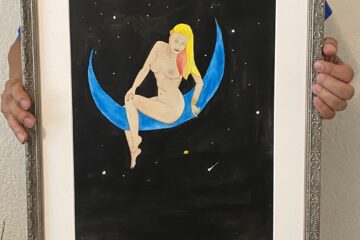I used to work with a guy who almost majored in Art. In his case, he really, really wanted to do Art but got scared and switched to a more “monetary” major halfway thru college.
And ironically, the first time I mentioned gouache, he asked “what the f- is gouache?”
So it’s weird to think that gouache is so obscure that you can take several semesters of Art and still not even know what it is.
Well, I’ll introduce gouache to you and also tell you how I use it.
My art consists of three things – watercolor, gouache, and ink. I’ll talk about inking watercolors another day. Now, let’s focus on gouache.
Gouache is simply opaque watercolors. Yes, it’s a subset of the watercolor umbrella. But unlike normal watercolors, gouache actually covers up what you paint over it, kind of like acrylics (but water based).
Whereas watercolors are transparent. When you paint multiple layers of watercolors, you can generally (not always) see the layers under it.
And with gouache, when you paint multiple layers, you’re pretty much wasting paint.
“Then why use gouache?”
Well, that’s exactly why I use it. When I want transparency, I use watercolors. Also, I prefer watercolors for most things. I think watercolors simply have better, richer colors.
But for 10-20% of my average paintings, I want some opaqueness. Thus, I’ll use gouache.
Like for instance, three of my five models have black hair. Keep in mind that I’m a pop artist, not a fine artist. I don’t go for realism. I go for what pleases the eye.
For their hair, I simply use black gouache. I feel that their hairstyle is plenty sufficient to speak for itself and I emphasize the lines rather than making my painting look like a photograph.
I also use white gouache for that white shine in their eyeballs. Go up to your best friend and tell her look at you to smile. Then take a look at her eyes in the photo.
You’ll notice a white spec in her eyeballs. You can choose to paint that or not paint that. It’s up to you. I usually (but not always) choose to paint it.
I’ll also use white gouache for the splashes of waves. I take a sponge, dip it in white gouache, and dab that gouache where the waves splash.
I’ll also use gouache to cover up boo boos. Bob Ross (who I love) will work a boo boo into his paintings. If I feel like I can’t do that, I’ll use a little bit of gouache to cover it up.
Note that this is yet another reason I emphasize really knowing your colors. You have to make it match or else it will look like crap.
“So if I paint with watercolors, should I also buy some gouache paints?”
That’s totally up to you. It totally depends on your style of painting.
Heck, you may even prefer gouache to watercolors. I know Olivia de Bernardinis loves gouache. Her gouache paintings look spectacular!
I do think that as an artist, you need to try a bunch of different things, then decide the direction you want to go.
I personally like using my three-headed monster of watercolor, gouache, and ink. That’s the direction I go.
You may hate gouache. You may hate ink as well. More power to you. Figure out what works for your style and keep getting better at it.
“What brands of gouache do you recommend?”
OK, I’ll readily admit, this is not my strength. I’ve tried tons of different watercolors but only two types of gouaches and ended up loving them both.
I like both M Graham (honey based) gouaches and Winsor and Newton. They’ve both been solid for what I do.
Also please note that I only have 17 different tubes of gouaches (whereas I got easily 3 times that number of watercolors). So before you take my advice, please read some other peoples’ reviews before you take my advice on gouache brands.
I’ll honestly say though for what I do, M Graham and Winsor and Newton are both solid brands for gouache paints.

0 Comments